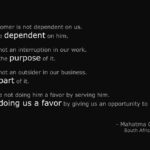Kenya’s Customer Service Week was recently celebrated at the end of November 2013 with an impressive figure of over 50 companies from both the private and public sector participating to demonstrate their commitment to appreciating and recognizing their internal and external customers. The week’s theme was “Celebrating the Kenyan customer at 50” in line with the country’s Jubilee Celebrations and organizations conducted various activities that left their customers feeling valued and appreciated including job swaps, provision of gift hampers, customer service quizzes, tips and training on customer service, red carpet welcome for customers, provision of refreshments and awards and recognition of customer service champions.
This then brought to the fore the question – where is the Kenyan customer placed 50 years down the line? Has anything changed? Has it been a good 50 years for the Kenyan customer? Does customer service in the country celebrate milestones in this period? Is the Kenyan customer celebrating and being celebrated? I suppose the answers would be as varied as individuals’ appreciation of service and their levels of expectation, but in general some gains have been made and there are lots more gains out there to be made to raise the standards of service excellence.
Communication with customers has improved with many service providers setting up call centres, e-help desks and joining the social media fray in a bid to be more responsive and communicate and engage with their customers. Customers are now better able to demand service and communicate their feedback on great or poor service as rendered. The social media platform particularly has shifted the attention corporates give to customer service to placement of more concerted efforts by the sheer number of users reached by service posts. The over quoted postulation by Jeff Bezos about one complaint on the internet reaching 6 million people isn’t overrated in its virulence. It is so and organizations are stepping up to claim their social media space. Another positive trigger effect is that monopolies that had hitherto assumed that customers will always be yoked to them are now sitting up and listening because the brand damage on the social media streets is enough to get any CEO off their high backed power chair to demand customer service intervention to reverse the trend.
The fad of putting up customer service charters seems to have taken the country by storm as well. And in as much as the writing on the wall may not translate into actualization, the fact that the organizations have thought through the brand promise and service delivery standards they would like to commit to their customers and documented these and proudly hang them up on their walls and posted them on their websites counts for much. The next step would then be to have systems and structures in place to deliver on these promises and for customers to be discerning enough to agitate for the promises to be delivered.
The government is also stepping up its efforts to deliver service to Citizens with every ministry, agency and department subject to a performance contract and the cabinet secretaries accountable for the overall service delivery. The public rating of public service has also served to put leaders on their toes if for nothing else to avoid the shame of being on a list-of-shame for non performance. The country was also pleasantly surprised by the recent introduction of the pilot citizen services center – Huduma, put up as an integrated one stop shop where citizen services are to be provided from one central location.
By and large there have been major service improvement milestones in both the public and private sector and there is a growing consciousness to put customers at the center of every organization’s focus. The role of customer service is slowly being accepted as critical and appears in many organization charts albeit often not at the very top. It is important to celebrate these baby steps for the much touted adage about every journey starting with a single step holds true, and these baby steps will soon be fully fledged runners’ sprints in the direction of celebrating the Kenyan Customer. Customer service is the driver of business that fuels return on investment and thus requires due recognition. I laud the Institute of Customer Service Kenya for recently launching The Service Excellence Awards 2014 during the customer service week that cut across industry and will seek to recognize, acknowledge and celebrate the success of corporates and individuals that provide exemplary customer service. Indeed the baby steps seem already to be taking off into a baby run at this rate?
The icing on the cake that would make the next 50 years a joy for the Kenyan customer would be to have customer service hold sufficient weight and take its rightful place right next to its sisters marketing, public relations and communications and have a comprehensive curriculum in the country’s institutions of higher learning. Customer service practitioners currently are persons who have studied other professional programmes, have a passion and flair for service and as an offshoot take up customer service roles. There is no degree programme that reads ‘Bachelor of Customer Service’ or say ‘Bachelor of Commerce – Customer Service’. This is indeed a cataclysmic cavity, a gaping canyon that needs to be filled towards the dream of raising the customer service game nationally.
I throw down the gauntlet to all customer service practitioners and enthusiasts to make dramatic history that will make for interesting reporting in the next 50 years by consolidating efforts and rallying together to develop curriculum, creating partnerships to institute customer service as a subject of focus and influencing government policy, decision makers and opinion leaders to raise the profile of customer service in this country and fly its flag high. And that ladies and gentlemen is our Kenya@50 Customer Service Challenge. Are we up to the task?









